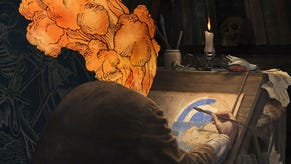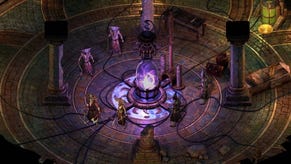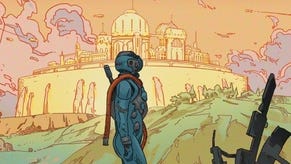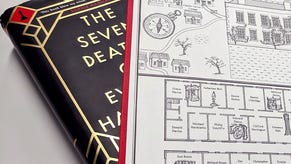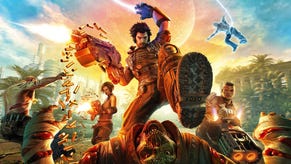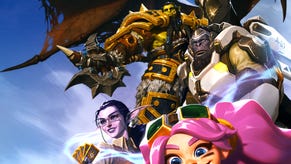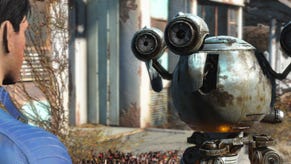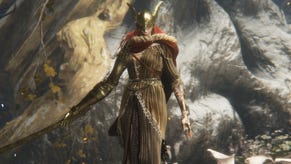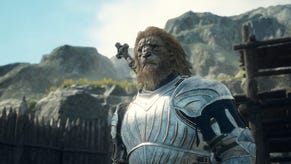Project Eternity crowd-funding ends, grand total now $4.3 million
Plus a look at what Obsidian's been up to.
Yes the Project Eternity Kickstarter ended with record breaking numbers a while ago, but PayPal donations stayed open. Yesterday marked the end-proper of crowd-funding, and the new grand total stands at $4.3 million, Obsidian announced.
That total can still budge slightly via a solo Slacker Backer tier left open on the Obsidian site - $29 for game code, basically. There's also the option to simply donate money for nothing in return.
There have been a few updates worthy of note since the Kickstarter drive ended. There's even been another picture! It's only a shot of a test environment with temporary art used to try out character pathfinding, but hey, it's something.

The Project Eternity team is in pre-production. The narrative team is fleshing out the world, its history, its people, its gods. Meanwhile, artists and programmers work on character customisation. They want individual pieces of equipment to show on characters look different when swapped. "There are thousands of different armour, weapon, head and hair customisation models for each race (male and female too!)," wrote Obsidian's Adam Brennecke in the Project Eternity forum.
(One of those programmers, Steve Weatherly, was introduced in his own forum post - you can do that with a small team. Weatherly's favourite Project Eternity weapon is the flail, and flails are brilliant.)
Project leader Josh Sawyer noted how he wants Project Eternity's armour to feel familiar to D&D but to rectify its "deficiencies".
His goals, therefore, are:
- Make wearing different types of armour a real choice for the player based on both character build and circumstance. E.g. a swashbuckling lightly-armoured fighter will tend to wear one of a variety of light armour types (maybe a gambeson or leather cuirass), but in a circumstance where protection is of utmost importance, the player may still choose to wear heavy armour with a loss in build optimisation.
- Disassociate armour value from class type in favour of different build types. E.g. a wizard can wear heavy armour and be a different type of wizard instead of just "a wizard who is bad".
- Allow a character to maintain a character concept throughout the game without suffering extreme mechanical penalties. E.g. a character who starts the game in some form of light armour can complete the game in some form of light armour with appropriate gameplay trade-offs compared to wearing heavy armour.
- Introduce new or upgraded armour types throughout the game instead of using ++ versions (which in itself would pose problems unless we directly duplicated A/D&D's d20-based attack mechanics).
Project Eternity's armour tiers could, he wrote, look like this:

Tier 1
- Doublet
- Hide Armour
- Scale Vest
Tier 2
- Gambeson (from Doublet)
- Leather Cuirass (from Hide Armor)
- Scale Armour (from Scale Vest)
- Mail Shirt
Tier 3
- Armoured Jack (from Gambeson)
- Leather Armour (from Leather Cuirass)
- Lamellar Armour (from Scale Armor)
- Mail Armour (from Mail Shirt)
- Half-Plate
But even then there are questions. For instance, should Hide Armour be made obsolete when Leather Armour comes along? What about those people (like me) who like playing "rough-hewn rawhide-wearing" barbarians? And if low-tiered armour were to remain viable, how should upgrades be translated to the player? With functional descriptions like "superior hide", fancy descriptions like "Villain Doublet" or numerical denotation like "Scale Armour +1"?
In a separate post, Josh Sawyer mulled the creation of a good RPG story and what it should entail.
"For us, it's important to let the player decide who he or she is in the story," he wrote. "That means when you set aside class, race, magic missiles, and all of the other goodies, the player needs to be able to define his or her own motivations, attitudes toward others, and ways of resolving problems in the story."
"Because this is the first story your characters will shape in this world," he went on, "we want to start with something small that grows into something larger. As we have hinted before, the story opens with the player's character witnessing a supernatural event that puts him or her in a difficult situation. The full ramifications of what you become a part of are not immediately apparent, but you quickly become aware that you have... new problems.
"Dealing with these problems makes you realise that resolving your situation is inexorably linked to the fates of many others. In some cases, these 'others' are individuals. In others, they are much larger groups of people. You will get to interact with them all in various ways over the course of the story. If we do a good job in developing these groups and characters, the decisions you make in the course of resolving your problems will be interesting and difficult to make."
Project Eternity will be built by a small team on the Unity engine. Being small means there's less need for managers, which means more resources can be used on design, as Adam Brennecke deftly explained with a pie chart.
That's about all there is at the moment. There are video updates to accompany some of these posts on the official Project Eternity forum and they offer a bit more fluff.
Remember, Project Eternity won't be done until 2014.


